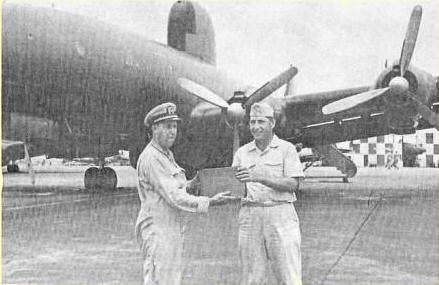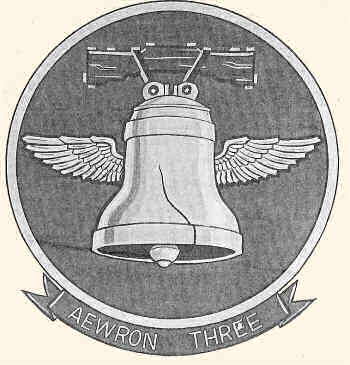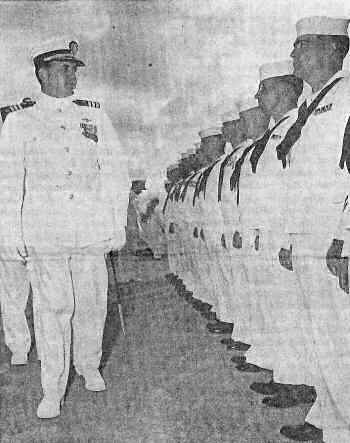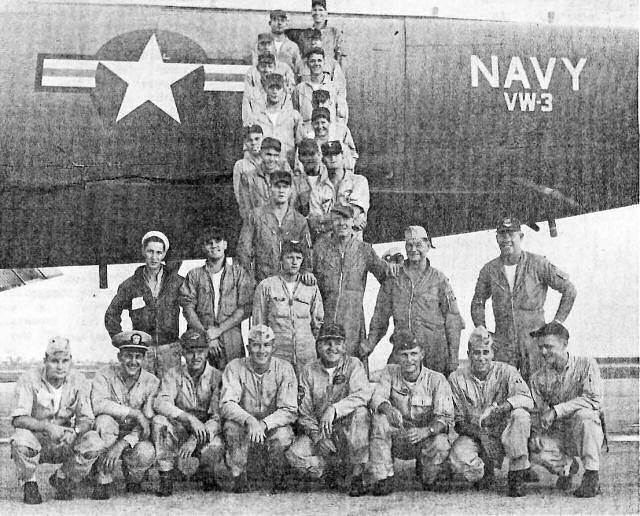 AIRCRAFT TRANSFER MADE -- J. A. Morrison (right), VW-3 Maintenance Officer present logbooks to
LCDR Michel VW-1 Maintenance Officer after completion of his acceptance test flight of PM-1. It
was the first aircraft to be transferred from AEWRON Three to AEWRON One.
AIRCRAFT TRANSFER MADE -- J. A. Morrison (right), VW-3 Maintenance Officer present logbooks to
LCDR Michel VW-1 Maintenance Officer after completion of his acceptance test flight of PM-1. It
was the first aircraft to be transferred from AEWRON Three to AEWRON One.
Airborne Early Warning Squadron THREE (AEWRON THREE or VW-3) will be decommissioned on board the Naval Air Station, Agana, Guam by her Commanding Officer, CDR P.W. Ustick in June 1960.
AEWRON THREE based on board NAS Agana, Guam has as her primary mission Radar Airborne Early Warning coverage for the Seventh Fleet in the Far East. Operating out of Okinawa, Japan and the Philippine Islands as well as Guam, her gray Lockheed WV-2 Radar Super-Constellations have become a familiar sight throughout the Far East. The aircraft work in close liaison with the Carrier Task Forces providing close and distant early warning and control of intercepts.
The squadron also conducts typhoon reconnaissance and search and rescue missions as assigned. The squadron is composed of approximately 508 men, 91 officers and nine WV-2 type aircraft.
Airborne Early Warning Squadron THREE was first commissioned on March 19, 1952 as Weather Squadron ONE (VJ-1) at Seattle, Washington and in July of the same year moved to the Naval Air Station, Agana, Guam under the Operational control of Commander Naval Forces Marianas. With an allowance of six P4Y-2S aircraft the squadron had the mission of providing weather reconnaissance in the Pacific Area for Fleet Weather Central, Guam. Other missions were to conduct island surveys for the Trust Territories.
 Airborne Early Warning Squadron Three Insignia.
Airborne Early Warning Squadron Three Insignia.
 AEWRON THREE INSPECTED -- CDR P. W. Ustick, USN Commanding Officer of AEWRON Three inspects
squadron enlisted men at a recent inspection held at the Naval Air Station.
AEWRON THREE INSPECTED -- CDR P. W. Ustick, USN Commanding Officer of AEWRON Three inspects
squadron enlisted men at a recent inspection held at the Naval Air Station.
After one and one half years of service the squadron designation was changed from VJ-1 to VW-3, Airborne Early Warning Squadron THREE and conversion was begun to P2V-5JF type aircraft. The primary mission of the squadron continued to be weather reconnaissance.
In October of 1955, to further increase its effectiveness, Airborne Early Warning Squadron THREE received the first of its WV-3 Radar Super-Constellation weather reconnaissance aircraft.
During 1956 AEWRON THREE began participating in air defense and Bogey detection exercises and in the latter part of the year the operational of the squadron passed to Commander Seventh Fleet. The primary mission then became Airborne Early Warning for the Seventh Fleet with Weather reconnaissance as a secondary mission.
In 1957 the last of the squadron's P2V's and WV-3's were phased out and by the first part of 1958 AEWRON THREE had received twelve WV-2 Radar Super-Constellation Airborne Early Warning aircraft.
When the Seventh Fleet moved into the Formosa area during the Taiwan crisis in 1958 VW-3 was called upon to provide a continuous twenty-four Radar coverage from August thru November operating out of the Philippines.
Despite the Philippine monsoon season AEWRON THREE flew 1477 hours in September and 1511 hours in October for an all time squadron record.
In its normal operations VW-3 has alternated with VW-1 in five week shifts providing AEW coverage for the Seventh Fleet as well as participating in the regular fleet exercises. In addition VW-3 has provided weather reconnaissance when required. Crew #3 with the skipper aboard welcomed in the new year of 1960 while tracking typhoon Harriet between Guam and the Philippines.
 LAST FLIGHT RETURNS -- PM-6 was the last aircraft to return from Airborne Early Warning Squadrons Three's
final operational deployment to the Far East. Crew of PM-6, with commanding officer of AEWRON Three, CDR
P. W. Ustick, (front row center) on board, posed for this last family portrait.
LAST FLIGHT RETURNS -- PM-6 was the last aircraft to return from Airborne Early Warning Squadrons Three's
final operational deployment to the Far East. Crew of PM-6, with commanding officer of AEWRON Three, CDR
P. W. Ustick, (front row center) on board, posed for this last family portrait.
AEWRON THREE has participated in numerous search and rescue missions from Wake Island to Japan and the Philippines providing various services including visual search, radar vectoring of other aircraft, or acting as On Scene Commander coordinating the searches. AEWRON THREE regularly provides Navigational assistance for jet and single engine type aircraft in the Pacific area.
Since VW-3 was moved to Guam in 1952 the squadron has flown 41,500 hours or an average of about 15 hours every day and in that time has covered a distance equivalent to 17 round trips to the moon. Despite the average 6000 hours flown each year, VW-3 has been accident free since it received its VW-2's over two years ago.
The officers and men of the squadron have already been at work for several weeks at the task of deactivating the squadron. Of the squadron's 600 personnel, a large share will remain on Guam and be attached to other activities at NAS Agana. Part of the AEWRON THREE's aircraft will be transferred to AEWRON ONE, the other Airborne Early Warning Squadron on Guam, and part of them will be sent back to the states.

